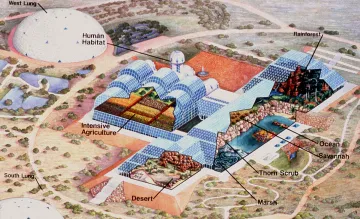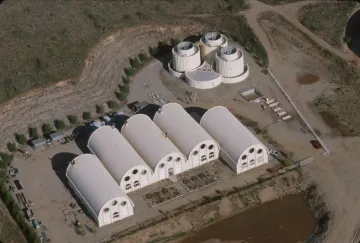Biosphere 2 advances our understanding of natural and human-made ecosystems through integrated research that drives the discovery and development of interventions that increase the resilience and sustainability of Earth systems and human quality of life. We advance research in our unique facilities, conduct interdisciplinary science education, and foster leadership initiatives focused on developing scalable solutions for our planet and beyond.
History
The University of Arizona assumed ownership of Biosphere 2 in July 2011. A generous gift from the Philecology Foundation helps fund Biosphere 2 operations and some research projects. Other grants and awards, primarily from the National Science Foundation, also support research activities.
In the 1800s, the Biosphere 2 property was part of the Samaniego CDO Ranch. After several changes of ownership, it became a conference center in the 1960s and 1970s, first for Motorola, then for The University of Arizona. Space Biospheres Ventures bought the property in 1984 and began construction of the current facility in 1986 to research and develop self-sustaining space-colonization technology.

Two missions, between 1991 and 1994, sealed Biospherians inside the glass enclosure to measure survivability. Behind this highly public exercise was useful research that helped further ecological understanding. Several first-person accounts have been published by former crew members that provide different perspectives on the experiment.
In 1994, Decisions Investments Corporation assumed control of the property and Columbia University managed it from 1996-2003 and reconfigured the structure for a different mode of scientific research, including a study on the effects of carbon dioxide on plants. Columbia also built classrooms and housing for college students of earth systems science.
The property was sold June 4, 2007, to CDO Ranching and its development partners who then leased the property to UArizona from 2007-2011. The enclosure now serves as a tool to support research already underway by UArizona scientists. As a laboratory for large-scale projects, such as the Landscape Evolution Observatory , the university's stewardship of Biosphere 2 will allow the UArizona to perform key experiments aimed at quantifying some of the consequences of global climate change.
Fast Facts
Biosphere 2 by the Numbers:
- 3.14 acre research facility
- 7,200,000 cubic feet under sealed glass; 6,500 windows
- 91 feet at highest point
- sealed from the earth below by a 500-ton welded stainless steel liner
- 40-acre campus
- 300,000 sq. ft. of administrative offices, classrooms, labs, conference center, housing
- Elevation is 3,820 feet above sea level
- Over 3,000,000 visitors since 1991
- Over 500,000 K-12 student visitors since 1991
Name
- “Biosphere 2” derives from the idea that it is modeled on Earth, Biosphere 1
Biomes under Glass
- Ocean
- Mangrove wetlands
- Tropical rainforest
- Savanna grassland
- Fog desert
Mechanics of Biosphere 2
The basement area of Biosphere 2, known as the technosphere, covers nearly 3.14 acres. It is where all the electrical, plumbing, and mechanical systems are housed. There are 26 air handlers located in the technosphere. The air handler units can heat and cool the air, remove particles from the air, maintain humidity levels and generate condensate water (for rain, fog and filling the ocean).

The building with the five arched segments and three towers is the Energy Center complex. The Biosphere 2 laboratory requires continuous power to maintain proper conditions for the living organisms inside and for ongoing experiments. Temperature rise following power failure on a sunny summer day could, within 20 minutes, irreparably damage the Biosphere 2's biomes.
Within the five arches are two large generators. The primary generator uses natural gas for fuel and a back-up generator uses diesel fuel. In addition to the large generators inside this building, there are also boilers to heat water and chillers to cool water. The large towers are used to cool air by drawing it across a column of water.

